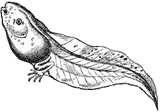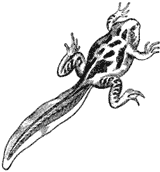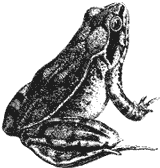Hey, Tortuga Tex, Tell Me More About Amphibians

Amphibian (am-FIB-ee-an) - These are really
cool animals -- for real!
Amphibians are cold-bolded vertebrates (animals with
backbones).
Being "cold-blooded" means that they have to use their
surroundings
to warm up or cool down. People can sweat or shiver to help keep
their
body temperature where it should be, but cold-blooded animals
can't do this.
Amphibians sun themselves or in hang out in water or cool shade
to keep comfortable.
But just doing this doesn't make an animal an amphibian!
The most interesting fact about amphibians is that they live
two lives!
The first is on water, and the second is on land! Amphibians lay
eggs
in water that hatch into larva (LAR-vah). Larvae (that's more
than one larva)
live in water like fish. Larvae grow and change through a process
called
metamorphosis (met-ah-MOR-fo-sis). During metamorphosis, larvae
grow lungs
and leave the water to live on land, but visit water for food, to
lay eggs,
and to cool off or warm up.
Frogs and toads have one of the most interesting changes in
metamorphosis.
They start out as eggs, then hatch into tadpoles (larva) that
look like
chubby fish. Tadpoles metamorphose by growing legs and lungs and
slowly
lose their tail until they look like an adult frog or toad.
Fun to Know Facts:
Frogs have smooth skin and have long legs for leaping and
jumping.
Toads have dry, warty skin (but don't give you warts!) with legs
built
for hopping.
Changing from tadpole to frog or toad can take anywhere from a
few weeks
to two years, depending on the species. Can you guess which
tadpole takes
two years to metamorphose into an adult? It's the American
bullfrog!
Frogs, toads, salamanders and newts are all examples of amphibians.

Texas Amphibian Watch - Adults and classes in Texas
schools
are watching and reporting on amphibians in their area to help
scientists
learn more about what is happening to amphibians in Texas.
Do we have more or fewer amphibians? What kinds of amphibians
live in
your area? People involved in this project use field guides, web
sites
and audio tapes to learn to identify the various species of frogs
and
toads native to their area by sight and by listening to their
calls. Information
about where our frogs and toads live, and how many are there,
will help
scientists better understand the decline in amphibian populations
in Texas.

[top]
|


